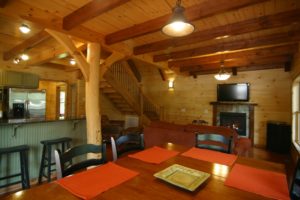So your timber frame house or bungalow has been raised, what now? Enclosures finish a timber frame house. You can expect your timber framing company to take care of the enclosures of your house. Most of the companies today are using structural insulated  panels also known as SIPs as enclosures to their frames. These panels are easy to install, can be used as floors, walls and even roofs. They have been proven to be the best way to enclose and insulate. Installation of SIPs is usually included in the total cost the what the timber frame company charges you.
panels also known as SIPs as enclosures to their frames. These panels are easy to install, can be used as floors, walls and even roofs. They have been proven to be the best way to enclose and insulate. Installation of SIPs is usually included in the total cost the what the timber frame company charges you.
Apart from the SIPs, there are other ways to enclose a frame. Sometimes, the methods for timber frame and conventional stick-built construction are combined together, resulting in a hybrid building. When the panels are all in place, roof work follows. Doors and windows would soon be installed next. The contractor can start with the electrical, flooring and plumbing works right after. Decorating the home’s interior should be the last thing in mind.
The architectural magnificence of a timber frame mainly lies in the kit itself being left exposed inside the structure. The more elaborate the design is, the more fascinating it becomes. What adds to the grandeur of the design is that different finishing surfaces can be applied to the timbers. As soon as the joinery and edging is complete, you are at the liberty to pick which finishing surface your timber framer should apply. Timbers can be sandblasted, smooth planed, wire brushed, scalloped and hand-hewn among others.
The flexibility of the plans will let you incorporate any style you want . You can leave it as open as it is or put up some walls and partitions for rooms and divisions. Its interior designing is normally in the scope of responsibilities of an architect or designer, although there are some companies that offer extended services. It would be better if you are with the company that can help you with your home’s interior arrangements. If not, you can always hire contractors to do the job for you. If you want to cut expenses, you can take charge yourself. Doing this will not only save you money but would also give you the chance to put in your own creative ideas for the interior of your newly-built home.
In this type of construction, the timber frame is the not the only thing that is laborious and requires experience. As soon as your timber frame is erected and enclosed, finishing its interior and exterior should not be so difficult especially if you have hired contractors who will do all the work for you. Remember that the exposed timber framework is an art in itself, so there’s no need to put in much effort to beautify a structure that’s already stunning.
When green timbers are used, the timbers will shrink over time. Few publications address the affect of this shrinkage on how and when the structure should be enclosed. I have seen timber frame structures in my area (Eastern Ontario) left open for over a year to allow for proper curing. This also has the effect of reducing the amount of checking in the timbers. Finding out you have to wait months before you move in shouldn’t ome as a surprise
Few publications address the problems that can occur when using stick framing methods betweem the timbers to enclose the building. Moisture may collect in the gaps created by shrinkage not to mention what happens when the timbers shrink and drywall attached to the stick frame does not.
I am a timber frame fan and have done a timber frame arbour and a 16 x 10 wood shed where shrinkage is not an issue.
I wonder why there is so little information on this issue.
You are right, I did a quick search too and did not find much information on it too. Will get something on the site in the next few months. Timbers do shrink after the frame goes up but then as the season change it will also expand and contract for the rest of its life. Taking this into consideration is important to the health of the structure.
We are planning on building a Timber Frame in the very near future and plan for it to be our retirement home so plan on living there for a long time. Any updates on this topic? We were looking at attaching the drywall directly to the timbers and then the SIPS (OSB on both sides) to the timbers. Hopefully should allow for some movement of the timbers with little movement between drywall and timber. Thoughts?
I would not recommend that you connect the drywall to the timbers. The timbers are going to move, shrink, and twist over time which may cause the drywall to crack. The best way to handle it is at https://timberframehq.com/timber-construction-detail-of-a-post-and-conventional-framed-wall/.
I am building a TF shed and want to enclose by wrap and strap with drywall as the interior visible face. I am intending on fixing plywood spacers to the exterior surface of the posts as in your linked illustration, and sliding the drywall into the gap between the spacers and the posts. Should I fix this drywall to the plywood, or can it just sit there? Thank you.
I would recommend that you screw the drywall off to anything that will help hold it flat and minimize movement. You do not want to attach it to the plywood spacer. What is your overall built-up of your wall?